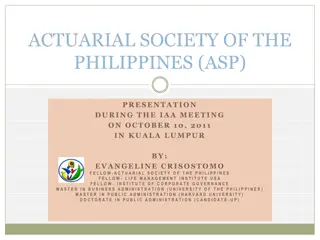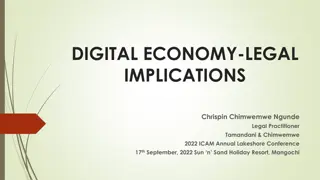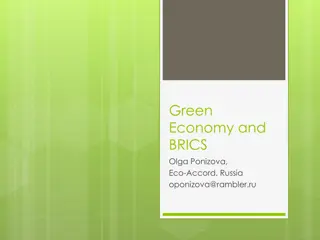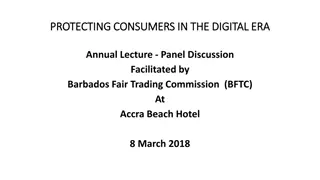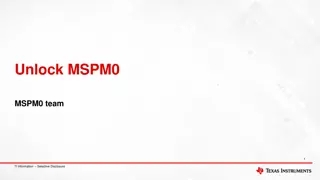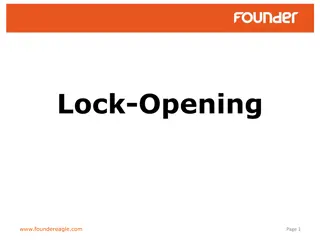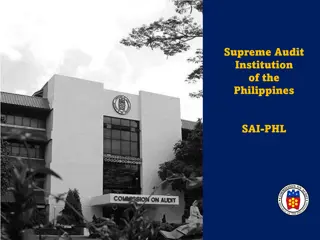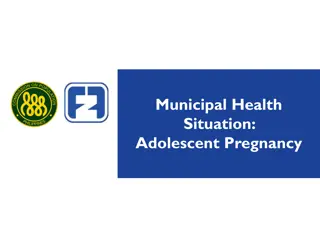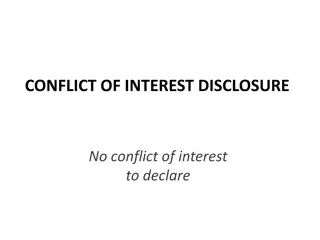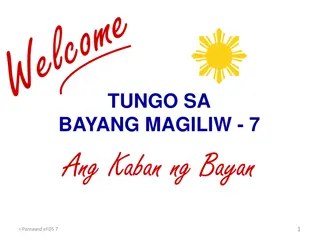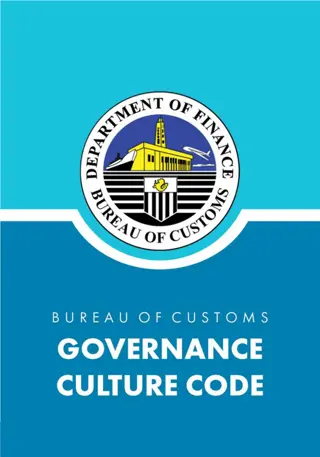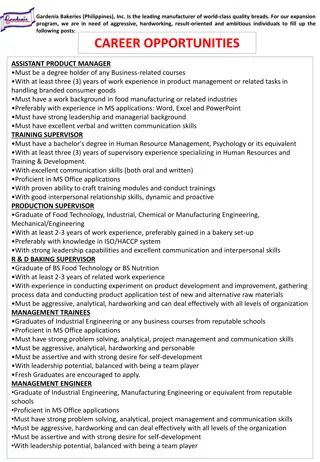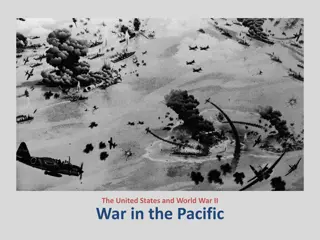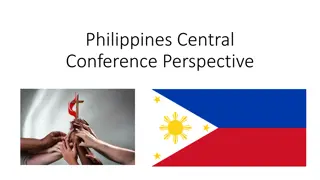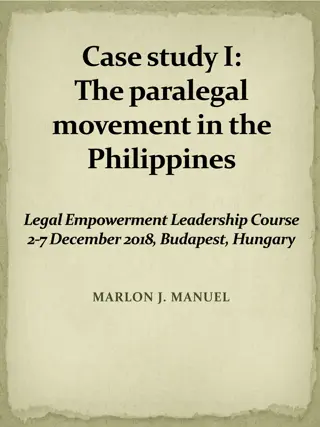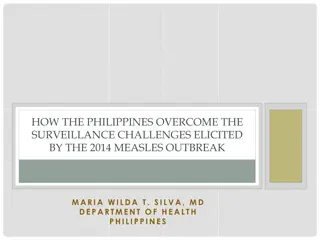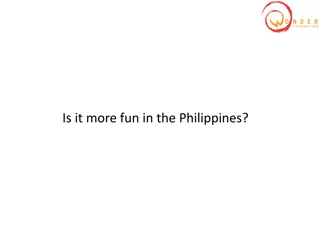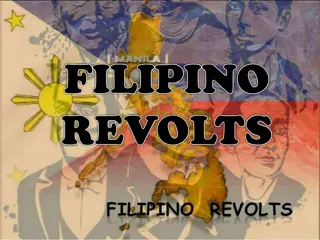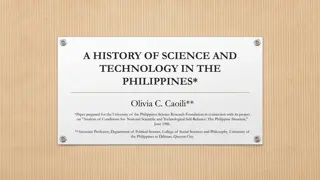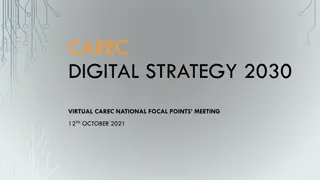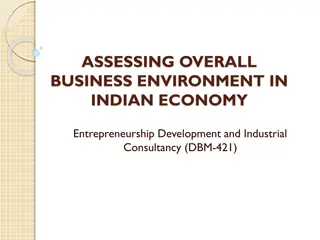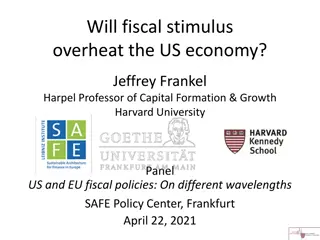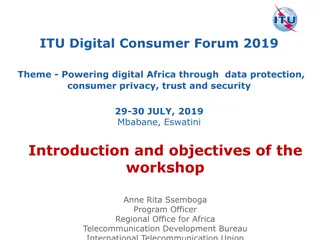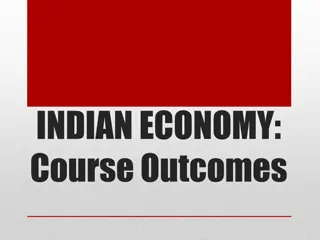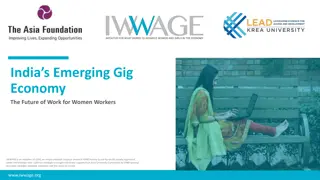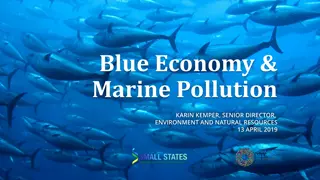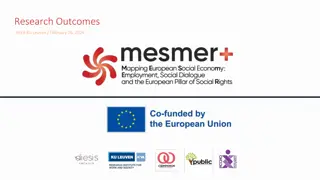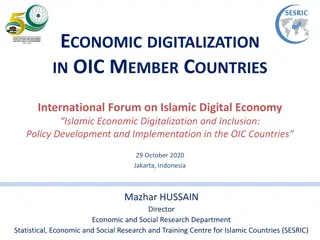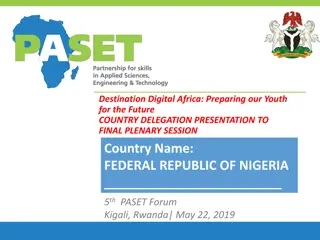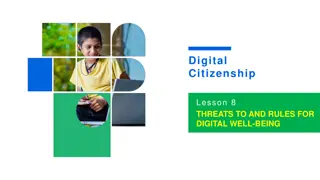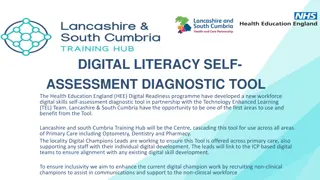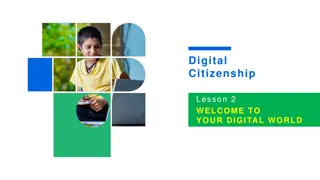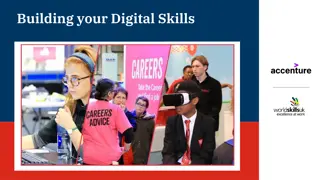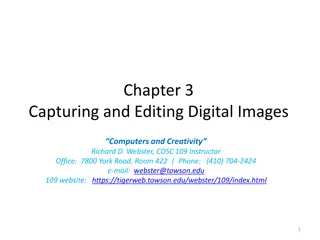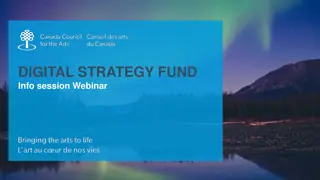Unlocking Potential: Digital Economy in the Philippines
The report discusses the Philippine digital economy, focusing on last-mile consumers, SWOT analysis, and case studies like the TESDA Online Program. It highlights strengths like mobile market development, opportunities for growth, and challenges such as IT infrastructure issues and job mismatch. Recommendations for improving digital literacy and financial inclusion are also provided.
Download Presentation

Please find below an Image/Link to download the presentation.
The content on the website is provided AS IS for your information and personal use only. It may not be sold, licensed, or shared on other websites without obtaining consent from the author. Download presentation by click this link. If you encounter any issues during the download, it is possible that the publisher has removed the file from their server.
E N D
Presentation Transcript
Philippine Country Report Regional Inclusive Growth Project (Diginomics I) Unlocking the Potential: Digital Economy in India & South East Asia Hotel Radisson Suites Sukhumvit, Bangkok, Thailand (August 23, 2018) Dr. Francis Mark A. Quimba, Research Fellow Mr. Sylwyn C. Calizo Jr., Research Analyst II Philippine Institute for Development Studies Surian sa mga Pag-aaral Pangkaunlaran ng Pilipinas www.pids.gov.ph 1
Presentation outline Introduction: SWOT analysis of the Philippine digital economy Case studies: TESDA Online Program and CARD Bank s konek2CARD Concluding remarks: Policy recommendations 2
Reaching the last mile consumer Last mile consumers are understood to be individuals or households that are willing yet unable to pursue their human aspirations following a mixture of financial, geographic, or cultural obstacles. This would include: The poor (i.e., those living at USD1.90 per day) Housewives especially in highly patriarchal societies (e.g., inability to pursue further education) Overseas Filipino Workers (i.e., Filipino workers distanced from their families often for years) Households in far flung areas away from town or city centers The digital economy allows for services to reach the last mile consumer. 3
SWOT analysis of the Philippine digital economy STRENGTHS WEAKNESSES Strong and developed mobile market Majority of Filipinos being proxy users Households with OFWs are more likely to access the internet Filipinos are more welcoming to digitalization Efforts to improve digital literacy, financial inclusion, and digital service Insufficient IT infrastructure Slow average internet speed across the Asia-Pacific Localized access divides Cybersecurity issues and lack of public awareness OPPORTUNITIES THREATS Smartphone ownership grows rapidly Mobile market pioneer across the Asia-Pacific Demographic advantage and high GDP growth rate in recent years Optimism in the Duterte administration s Build, Build, Build and National Broadband Network Prices of ICT services among highest in ASEAN Low access to landline connection in provinces Financial limitations to last mile consumers Job mismatch and a jobless growth despite high GDP growth rates Lack of studies that explores sector-level or firm- level effects of digitalization in the Philippines 4
Case Study One: e-Education THE CASE OF THE TESDA ONLINE PROGRAM (TOP) 5 www.pids.gov.ph
Background of the TESDA Online Program (TOP) Technical and Vocational Education and Training (TVET) in the Philippines has been viewed as a tool for human capital development. In 2016, about 2.3 million are enrolled in TESDA, the government institution responsible for delivering free TVET in the Philippines. In 2012, the first Philippine Massive Open Online Courseware was launched through the TOP. It started with six courses covering ICT, food and beverage servicing, and housekeeping. As of February 2018, however, it has widened the course selection to 59 with topics across 12 sectors. The TOP utilizes an open education resource framework that aims to make technical education accessible and inclusive using ICT having the goal of [learning] at your own pace, in your own time, at your own place. With the vision of reaching the last mile consumer and to empower the reached, the TOP identifies as primary clientele students, out-of-school youths, unemployed adults, local and overseas workers, and professionals. The TOP allows for reaching Overseas Filipino Workers (OFWs) although awareness may be limited at present. 6
Highlights of the case study There are about 1.1 million registered TOP users online with 71.0 percent enrolled in at least one TOP course. Females comprise 60.0 percent of the TOP users with 23.8 percent of sessions occurring abroad. As of May 2017, 46.8 percent of enrollees have already completed their course. Most enrollees take up courses either in ICT (51.0%) or tourism (20.7%). Courses with the highest percentage of completers as a proportion of enrollees are heating, ventilating, air conditioning, and refrigeration (77.2%), ICT (65.5%), and TVET (59.9%). The majority of TOP users are college graduates (65.0%) and are 25-34 years old (43.6%). Most users are located in Balance Luzon (42.7%) and the National Capital Region (34.2%). 16.5% of TOP users reside in low HDI areas and 3.1% are in 4th and 5th class municipalities in the Philippines. These municipalities are categorized with having the lowest average annual incomes. Evidence of reaching last mile consumers. 7
Case Study Two: e-Finance THE CASE OF CARD BANK S KONEK2CARD 8 www.pids.gov.ph
Background of CARD Banks konek2CARD (k2c) The Center for Agriculture and Rural Development (CARD) Bank is a microfinance-oriented rural bank in the Philippines established in 1997. Its primary client is the poor especially among women and families situated in the countryside. As of 2017, CARD Bank has 69 microbanking offices serving 2.3 million clients nationwide. Most of these are females (75.0%) of which three-quarters are married. More than half of the active clients are borrowers. Most take up microfinance loans (72.3%). CARD Bank has made attempts to introduce technology into their system with the Mobile Financial Services (MFS) in 2011. This would allow members to conduct financial transcation through their mobile phones. However, this uses instead the text messaging and does not require a smartphone to operate. The Bank s second attempt was with the k2C. Unlike the MFS, the k2C operates with a mobile banking application that would require mobile data and a smartphone. 9
Highlights of the case study Almost half are at least high school graduates (48.6%) with the majority being married (92.0%). Most of the clients (35.7%) have their own sari-sari store (neighborhood sundry stores) whereas a large proportion are engaged in business activities (40.4%). This implies that the majority of participants acquire their incomes from their own businesses. CARD Bank s clients open bank accounts primarily for savings (57.4%) and loans (31.5%). These are used for financing businesses and for their children s education. Clients reported that the transaction process got easier, faster, and convenient. Members are able to transact at any time of the day particularly during nighttime beyond oridnary business hours. Remote access to banking transactions allow them to save on transportation costs and time. This is especially true for farmers who are often distant from banks. Catering primarily to the poor, the absence of smartphones often bar them from using the k2c (i.e., access divide). Connectivity is likewise an important element in mobile application usage. 10
How does the TOP and the k2c help reach last mile consumers? Both the TOP and the konek2CARD spur economic development through digital technology. Its capacity to create opportunities and markets in which parties may undertake mutually beneficial transactions has been observed. The initial investment to establish their online platforms has allowed them to provide services to the marginal consumer at very little marginal cost. This embraces the birth of new internet-based business models. Both cases present similar weaknesses wherein the need to improve the digital technology infrastructure of the country, the reduction of the cost of internet access, and the need to provide additional features to further engage customers are observed. The TOP and k2c manifests that through digitalization, services are enabled to reach last mile consumers so long as access is made available (i.e., stable internet connection and access device). 11
Concluding Remarks SWOT ANALYSIS OF THE PHILIPPINE DIGITAL ECONOMY POLICY RECOMMENDATIONS 12 www.pids.gov.ph
Policy recommendations Reviewing the laws related to the provision of public goods and services particularly the internet. Ensure that the strategies of the Philippine National Broadband Plan are implemented. Establish a secure strong collaborative working relationship between key actors related to the digital economy. Ensure that the analog components are strengthened (i.e., rules, skills, and institutions). Prepare the service providers with the ability to use ICT to perform current and even new ICT-related tasks. Further promote the use of technology not only through intensive government promotion campaigns but also by assuring users that the ICT infrastructure is stable and resilient to cyber-attacks. 13
[ Thank you ] Philippine Institute for Development Studies Surian sa mga Pag-aaral Pangkaunlaran ng Pilipinas WEBSITE: www.pids.gov.ph FACEBOOK: facebook.com/PIDS.PH Service through policy research TWITTER: twitter.com/PIDS_PH EMAIL: fquimba@mail.pids.gov.ph scalizo@mail.pids.gov.ph 14


